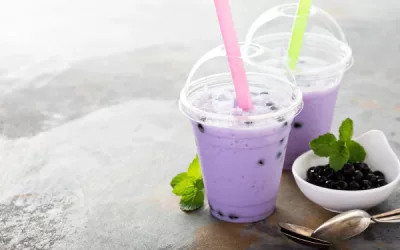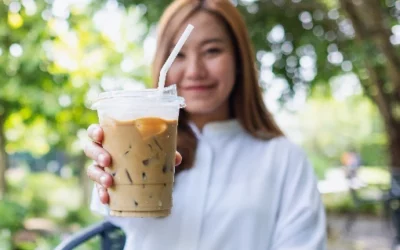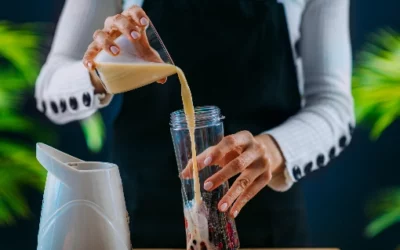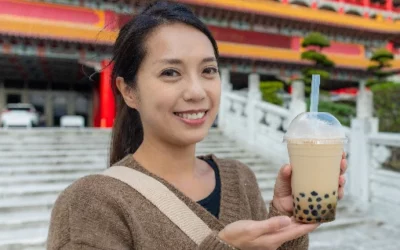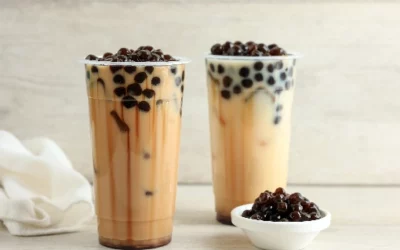Have you ever sipped a drink that transports you to a vibrant tea shop halfway across the world? Taro milk tea does just that! With its creamy texture and subtle sweetness, this trendy beverage has captured the hearts of tea enthusiasts everywhere. Understanding how to make your own taro milk tea is not just fun; it empowers you to customise it to your taste. In this ultimate guide, we’ll explore everything from its origins and ingredients to variations and health benefits, helping you elevate your tea game at home!
Table of Content
- What is taro milk tea?
- How do you make taro milk tea at home?
- What are the nutritional benefits of taro milk tea?
- What variations of taro milk tea can I try?
- How do I prepare boba pearls for taro milk tea?
- Where can I buy taro milk tea ingredients?
- What are the common misconceptions about taro milk tea?
- How can I enjoy taro milk tea outside of home?
- Conclusion
What is taro milk tea?
Taro milk tea is a creamy, sweet, and slightly nutty beverage that’s beloved in bubble tea culture. It has a vibrant purple hue, thanks to the taro root, which is the star ingredient. It’s made by combining taro root (either fresh or in powder form) with brewed tea, milk, and often boba pearls. This drink stands out not only for its unique flavour but also for its eye-catching colour.
This delightful drink has become a staple in many bubble tea shops around the world. Taro milk tea offers a mildly sweet taste with a hint of vanilla, making it a favourite among those who seek something different from the usual fruity or floral bubble tea options.
Where did taro milk tea originate?
Taro milk tea has its roots in Taiwan, the birthplace of bubble tea.
- Taro is a starchy root vegetable that’s been cultivated in many tropical regions for centuries.
- The drink emerged in the 1980s bubble tea boom in Taiwan.
- Bubble tea, also known as boba tea, combines tea with milk or fruit juices and chewy tapioca pearls.
- Taro milk tea gained popularity for its distinctive taste and vibrant colour, becoming a global sensation over time.
Bubble tea shops in Taiwan first experimented with various flavours and textures, leading to the creation of taro milk tea. Its success quickly spread to other countries, including the United States, Japan, and many parts of Europe.
What are the main ingredients in taro milk tea?
The main ingredients of taro milk tea are simple yet essential to achieving its signature taste and texture.
- Taro root or taro powder: Provides the sweet, nutty flavour and purple colour.
- Brewed tea: Usually black or green tea forms the base, adding depth to the taste.
- Milk: Whether dairy or non-dairy, it makes the drink creamy.
- Sweetener: Sugar or honey enhances the sweetness.
- Boba pearls: Chewy tapioca pearls add a fun and unique texture.
The combination of these ingredients creates a harmonious blend of flavours and textures. You can also find variations with coconut milk or even additional toppings like jelly cubes or popping boba.
How does the flavour of taro milk tea compare to other bubble teas?
The flavour of taro milk tea is unique and distinct when compared to other bubble teas.
- It has a creamy, slightly sweet, and nutty taste, unlike the fruity flavours of classic bubble teas like mango or strawberry.
- The natural vanilla undertone sets it apart from tea-forward options like matcha or jasmine.
- The texture is rich and smooth, often thicker due to the taro root.
- Its sweetness level is balanced, making it not overly sugary.
While many bubble teas focus on fruit or floral notes, taro milk tea offers a more earthy and comforting flavour profile. It’s perfect for those who want something indulgent and different from the usual bubble tea selections.
In the 1980s, during the height of bubble tea’s popularity in Taiwan, a small tea shop owner named Lin Hsiu Hui decided to experiment with adding sweet taro root to her milk tea. Little did she know, this experiment would lead to the creation of one of the most beloved bubble tea flavours.
Taro, being a staple in Taiwanese cuisine, offered a familiar yet innovative twist to the traditional milk tea. Her customers were instantly captivated by the unique taste and vibrant colour, and word of this new drink spread quickly.
Today, Lin Hsiu Hui is remembered as one of the pioneers of the bubble tea movement, especially for her contribution to the beloved taro milk tea.
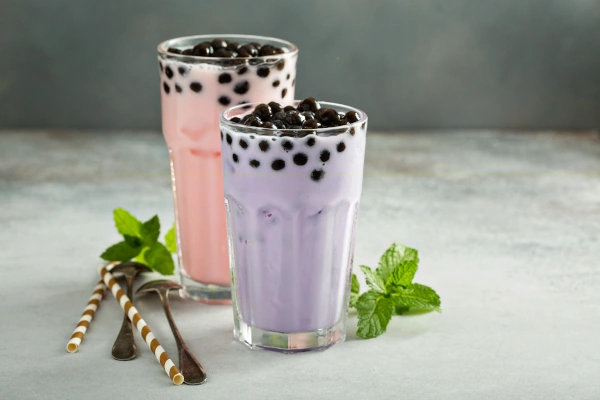
How do you make taro milk tea at home?
Making taro milk tea at home is a rewarding experience, and it’s simpler than you might think. This delightful beverage, with its vibrant purple hue and unique flavour, is perfect for impressing friends or simply enjoying on a lazy afternoon. To get started, you’ll need a few key ingredients and some basic kitchen tools. Below, I’ve outlined the step-by-step process to guide you through preparing this trendy drink.
To ensure clarity, I’ve also included a table that breaks down the ingredients and steps. This table will help you stay organised and ensure you don’t miss any crucial components. By following the table, you’ll know exactly what to do and when.
Ingredients and preparation steps for taro milk tea
The table below lists the ingredients you’ll need and the specific measurements. It also outlines the preparation steps, making it easy to follow along. Each row represents a different ingredient or step.
| Ingredient/Step | Measurement | Preparation |
|---|---|---|
| Taro powder | 2 tablespoons | Dissolve in hot water until smooth |
| Water | 1 cup | Boil for tea and taro powder |
| Black tea bags | 1-2 bags | Brew in hot water for 5 minutes |
| Milk or milk substitute | 1 cup | Stir into brewed tea and taro mixture |
| Sugar or sweetener | To taste | Mix into the drink |
| Boba pearls | 1/2 cup | Boil until soft, then soak in sugar syrup |
| Ice cubes | As needed | Add to the drink to chill |
Let’s break down the details from this table a bit more to make sure you’ve got everything you need. Start by preparing your boba pearls, as they take the longest. Boil them until they’re nice and soft, then let them sit in a sugar syrup to sweeten up.
What tools and utensils will you need?
Before diving into the preparation, gather the necessary tools and utensils. Having everything at hand will make the process smoother and more enjoyable.
- Saucepan: For boiling water and boba pearls.
- Whisk: To dissolve taro powder.
- Teapot or kettle: To brew tea.
- Mixing bowl: For combining ingredients.
- Strainer: To strain tea leaves if using loose tea.
- Tall glass: To serve the drink.
- Stirring spoon: To mix the final beverage.
Having these tools will simplify each step, ensuring your taro milk tea comes out perfect. Now, let me break down the process into easy-to-follow steps.
Step-by-step guide to making taro milk tea
- Prepare boba pearls:
- Boil water in a saucepan.
- Add boba pearls and cook until soft (usually 5-7 minutes).
- Drain and soak in sugar syrup.
- Brew black tea:
- Boil water in a teapot or kettle.
- Add tea bags and steep for 5 minutes.
- Remove tea bags (or strain if using loose tea).
- Mix taro powder:
-
- Dissolve taro powder in hot water.
- Whisk until smooth.
- Combine ingredients:
- Pour brewed tea into a mixing bowl.
- Add dissolved taro powder.
- Stir in milk (or milk substitute) and sweetener.
- Assemble the drink:
- Add cooked boba pearls to the bottom of a tall glass.
- Fill the glass with ice cubes.
- Pour the taro tea mixture over the ice.
- Serve and enjoy:
-
- Stir the drink to mix ingredients well.
- Enjoy your homemade taro milk tea!
This delightful drink has a rich history rooted in Taiwanese culture. Taro, a starchy root vegetable, has been a staple in Asian cuisine for centuries. In Taiwan, taro milk tea became popular in the 1980s when bubble tea shops started experimenting with different flavours and ingredients. It quickly became a favourite due to its creamy texture and unique taste.
I remember the first time I tried making taro milk tea at home. I was fascinated by its colour and taste, and the process was a fun weekend project. I gathered all the ingredients and followed a recipe similar to this one, and the result was a delicious, homemade version of my favourite café drink.
It became a treat, and I often experiment with different types of tea and milk. Give it a try—you might just discover a new favourite too!
What are the nutritional benefits of taro milk tea?
Alright, so you’ve hopped on the taro milk tea bandwagon. Glad you’re here! But you’re probably scratching your head and wondering, “What nutritional value could this Instagram-worthy drink possibly have?” Let’s dive into the nitty-gritty of what you’re actually sipping on.
Taro milk tea, that luscious purple wonder, isn’t just a pretty face. Taro root, the star of the show, is packed with dietary fibre, which is fantastic for your digestion. It also boasts essential vitamins like vitamin E, C, and B6, along with potassium and magnesium. Bet you didn’t think your trendy drink could be a vitamin powerhouse, huh?
Now, we can’t ignore the sweeteners that often get dumped into these drinks. They can turn your drink into a sugar bomb. Depending on where you get yours, the caloric content can range from “I can handle this” to “Oh no, my diet!” And don’t even get me started on the creamers. But fret not; alternative milks like almond, soy, or oat can save the day.
Is taro milk tea a healthy choice?
Hold your boba! Is this Instagrammable drink as healthy as it is trendy? Well, it depends.
- Taro root itself is a nutritional dynamo, boasting:
- Fibre – good for digestion
- Vitamins E, C, and B6 – great for the immune system
- Potassium – helpful for muscle function
- Magnesium – vital for many biological functions
- However, the overall healthiness of your taro milk tea hinges on:
- Sweeteners – overdoing it here can spike your sugar levels
- Caloric content – can vary wildly based on portion size and add-ons
- Type of milk – dairy vs. non-dairy options
So, before you declare this your go-to health drink, remember that moderation is key. Getting your taro bubble tea daily might not be the best idea if it’s loaded with sugar and full-fat milk.
How can I make taro milk tea healthier?
You’re in control! Here’s how you can turn your taro milk tea into a healthier, but still delicious, treat.
- Opt for less or no sugar: Most places give you the option to adjust sweetness levels. Choose wisely.
- Use alternative milks: Almond, soy, or oat milk can cut down on calories and saturated fat.
- Skip the boba: Pearls are fun, but they also pack extra calories and sugar.
- DIY: Making your taro milk tea at home can give you full control over ingredients.
When I make mine, I go for unsweetened almond milk, a touch of honey, and a sprinkle of cinnamon – voilà, a delicious yet healthier option.
What are the nutritional differences between dairy and non-dairy milk in taro milk tea?
The milk you choose can make or break the nutritional profile of your taro milk tea. Let’s break it down:
- Dairy milk:
- Higher in protein
- Contains natural sugars
- High in calcium and vitamin D
- Can be heavy in calories and saturated fat
- Non-dairy options:
- Almond milk: Lower in calories, low protein, often fortified with vitamins.
- Soy milk: Comparable to dairy in protein, often fortified, lower in saturated fat.
- Oat milk: Higher in fibre, moderate calorie count, good for those with nut allergies.
With this knowledge, you can pick the milk that best suits your dietary preferences and health goals.
In the late 19th century, bubble tea’s spiritual forefather—pearl milk tea—was beloved by tea enthusiasts in Taiwan. Initially, sweet potato and tapioca were used as the ‘pearls,’ making it an unconventional, yet delicious, beverage. Fast forward to today, the taro milk tea you sip echoes these culinary explorations, proving that innovation and tradition can blend beautifully and create new favourites that transcend time and borders.
What variations of taro milk tea can I try?
Let’s be honest. Taro milk tea is already a solid ten out of ten. But why settle for just the classic when you can spice things up a bit? Whether you’re a tea enthusiast or just someone looking for a refreshing twist to your boring cuppa, there are variations of taro milk tea that will blow your taste buds away.
From iced versions that chill you to the bone, to blended delights that hit the smoothie spot, there’s an adventure waiting in every cup. But wait, there’s more! Let’s dive into how you can tailor this trendy beverage to make it uniquely yours.
What are some creative twists on traditional taro milk tea?
If you’re tired of the same old same old, you can totally add a creative spin to your classic taro milk tea. It’s all about blending different flavours, experimenting with textures, and concocting new combinations.
- Iced Taro Milk Tea: Perfect for a hot day. Just add ice cubes and enjoy that cool, sweet, and starchy goodness.
- Blended Taro Milk Tea: Think of it as a milkshake but with a tea twist. Plush and creamy.
- Taro Milk Tea Float: Scoop in some vanilla ice cream, and voilà! You’ve got yourself a frothy, delectable treat.
- Taro Matcha Fusion: Mix taro with a hint of matcha; you’ve got an earthy, exotic drink—a combo that’s Instagram-worthy.
- Fruit-Infused Taro Milk Tea: Add some mango or strawberry puree for a fruity kick.
Taro milk tea doesn’t have to be boring. In fact, it should NEVER be boring. A little tweak here and there, and you’ve transformed your drink into something extraordinary.
How can I adjust the sweetness of my taro milk tea?
Everyone has that sweet spot, right? Whether you’ve got a sweet tooth or you’re cutting back on sugar, adjusting the sweetness of your taro milk tea is easy peasy.
- Honey: Swap out regular sugar for some honey. It’s natural and adds a floral note.
- Agave Syrup: For a lighter, healthier option.
- Brown Sugar: For a rich, deep molasses flavour.
- Stevia: Zero calories but all the sweetness.
- Sugar-Free Syrups: Plenty of flavours to choose from without the guilt.
A fun fact: Most bubble tea shops will let you customise the sweetness level. Whether you want it super sweet like your first crush, or just mildly sweet like a polite smile from a stranger, the choice is yours.
What toppings pair best with taro milk tea?
Toppings can take your taro milk tea experience from “eh” to “heck yeah!” Whether you’re team chewy or team crunchy, choosing the perfect topping can enhance your indulgence.
- Tapioca Pearls: The OG of bubble tea. Chewy, satisfying, and oh-so-addictive.
- Fruit Jellies: Adds a pop of colour and a burst of flavour.
- Whipped Cream: Because why not?
- Pudding: Soft, silky, and a match made in heaven with taro.
- Red Bean: A classic pairing in Asian desserts.
Choosing the right toppings might just be the most crucial decision you make all day. Well, aside from deciding whether or not to wear pants to your Zoom meeting.
How do I prepare boba pearls for taro milk tea?
Ah, taro milk tea – the delightful, Instagram-worthy bubble tea that has taken the world by storm. But what’s a good taro milk tea without some perfectly chewy boba pearls? Here’s how you do it.
First things first, grab a pack of those lovely tapioca pearls. You’ll usually find them in the Asian food aisle at your local supermarket, or you can order them online. Boiling these pearls is an art form; too little, they’re crunchy (yuck); too much, they disintegrate (double yuck). Here’s where timing and patience come into play.
How long do I need to cook boba pearls?
Think of cooking boba pearls like preparing pasta – al dente is the goal! You generally want to boil them for about 15 to 20 minutes. But remember, different brands might suggest different cooking times, so read those instructions!
- Bring water to a boil: Use a hefty amount, about 10 cups for every cup of boba.
- Add the pearls: Stir them in to make sure they don’t stick together.
- Boil then simmer: Let them boil for a solid 15 minutes, then reduce to a simmer for another 5 minutes.
- Rest them: Once they’re done, let them sit in the water for a further 15 minutes with the heat off.
Once you’ve followed these steps, they should be the right texture – firm yet chewy.
Next, don’t just dump them in your tea right away. They need a little R&R – rest and rejuvenation, if you will.
How do I store leftover boba pearls?
We’ve all been there: eyes bigger than our stomachs, resulting in a surplus of boba pearls. Not to worry, you can indeed make them in advance and store the leftovers. But, let’s do it right to prevent those pearls from turning into hard little rocks.
- Rinse the pearls with warm water once they’re cooked to wash off the excess starch.
- Sweeten them up: Soak them in a simple syrup (sugar water mix) for at least 30 minutes. This not only keeps them sweet but also prevents them from sticking.
- Refrigeration: Store them in an airtight container submerged in this sweet syrup. They’ll stay good for up to 3 days.
- Reheat gently: If needed, you can microwave them for about 20-30 seconds or pop them back into boiling water briefly to regain that chewy texture.
Doing this ensures your pearls are always ready for their starring role in your taro milk tea.
Can I make boba pearls in advance?
Who wants to boil boba pearls every single time you crave taro milk tea? No one. So yes, you can totally prepare them in advance. Pre-cooked pearls can become your best friend when you’re hit by that bubble tea craving out of the blue.
- Cook and cool: Follow the same cooking steps as above.
- Sweeten and store: As like with storing, keep them in simple syrup.
- Portion control: You can even portion them out for single servings before refrigerating to make your life easier.
- Reheat as needed: Just a quick nuke in the microwave or a small simmer, and you’re good to go.
Getting into a routine of making boba pearls in advance can streamline your taro milk tea-making process.
Back in the day in Taiwan, the birthplace of bubble tea, experimenting with different ingredients was how boba tea came to be. Lin Hsiu Hui tossed some tapioca balls into her tea during a staff meeting in the 1980s.
She didn’t know it then, but she was cultivating a future global phenomenon. Think of yourself as Lin Hsiu Hui, innovating the boba tea culture with your perfect pearls. Who knows, you might just stumble upon the next big tea-time trend!
Where can I buy taro milk tea ingredients?
Let’s face it, finding the holy grail of taro milk tea ingredients can feel like searching for a needle in a haystack. But fret not, my fellow tea enthusiasts, for there are plenty of options you can explore to get your fix.
You can start your treasure hunt in local grocery stores, but don’t hold your breath here; these places might only carry the basics. Hit the jackpot at specialty Asian markets, where you’re more likely to stumble upon the real deal: taro powder, boba pearls, and all the fixings. And if you’re not ready to face the outside world, online retailers are your sweet escape, offering a plethora of choices right at your fingertips.
What should I look for when buying taro powder?
When it comes to buying taro powder, you’re after these gold nuggets:
- Quality: Make sure the powder is vibrant in color and free from artificial dyes. Natural hues are a good sign of high-quality taro.
- Ingredients: Check the label for any unwanted additives or preservatives. You want the closest thing to pure taro.
- Texture: Look for a fine powder, as it dissolves more easily in your milk or tea.
- Brand Reputation: User reviews are your best friend. If a brand has consistently high ratings, it’s worth considering.
- Shelf Life: Fresher is always better. Make sure to check the expiration date to avoid any unpleasant surprises.
Trust me, taking the time to find a good powder will elevate your tea game to legendary status.
So, the next time you’re staring down a shelf of taro powder, use these tips to pick a winner. Your taste buds will thank you.
Can I find taro milk tea ingredients in regular supermarkets?
Yes, you can find taro milk tea ingredients in regular supermarkets, but let’s be real—only if you’re exceptionally lucky. Here’s what you might find:
- Basic Tapioca Pearls: Occasionally found in the international or baking aisle.
- Taro Powder: Rare and usually not as high-quality, but sometimes available.
- Condensed Milk and Creamers: Necessary for that silky smooth texture, these are easy finds.
- Sweeteners: This one’s a no-brainer; the sugar section has got you covered.
- Fresh Taro: Typically available in larger supermarkets with extensive produce sections.
In most cases, regular supermarkets don’t carry the whole shebang. But, if you’ve no other options, you can at least scrape together the basics.
For the best results, branch out to specialty stores or dive into the plethora of online retailers.
What are the common misconceptions about taro milk tea?
Alright, let’s spill the tea—specifically, taro milk tea. It’s the darling of Instagram feeds and the sugar rush you didn’t know you needed, but there’s a lot of misinformation swirling around this vibrant beverage. From health benefits to its sugar-laden nature, and even the use of artificial flavouring, it’s high time we separate fact from fiction. Let’s dive into the most common misconceptions about taro milk tea.
Is taro milk tea always made with artificial flavouring?
Let’s get one thing straight: not all taro milk tea is artificial! Yes, some cafes and chains might take the shortcut, opting for powders and syrups to achieve that signature lavender hue and sweet taste. However, purists and high-quality tea shops? They use the real deal.
- Natural vs. Artificial: Real taro root boasts a nutty and somewhat vanilla-like profile. It’s hard to replicate, but not impossible.
- Quality Control: Stick to reputable, artisanal tea shops if you’re after authenticity.
- Powdery Perfection?: Some powders might be made with genuine taro extract, but you’ve got to read those labels.
- DIY Delight: Making it at home ensures you know what goes in your cup. All you need is taro root, milk (or milk alternatives), and a bit of sweetener.
- Market Trends: The demand for natural ingredients is rising, encouraging shops to ditch the fake stuff.
So, no, taro milk tea doesn’t have to be artificial. You’ve just got to be picky about where you get it from!
Does taro milk tea contain a lot of sugar?
Here’s where things get sticky—literally. Like many beloved beverages, taro milk tea can be a sugar bomb, but it doesn’t have to be that way.
- Sweetness Spectrum: Some versions are as sweet as a dessert, while others are mildly sweetened for those watching their sugar intake.
- Custom Orders: Many tea shops let you customise sugar levels. Go for half sugar, no sugar, or anywhere in between.
- Home Brew: When you make it at home, you control the sweetness. Stevia, honey, or even cutting it out entirely are all viable options.
- Calories Count?: The more sugar, the higher the calorie count. Keep that in mind if you’re counting calories.
- Healthier Alternatives: Look for places that use alternative sweeteners or lower glycaemic index sugars.
So sure, it CAN be a sugar-laden treat, but it doesn’t HAVE to be. You’re the boss of your own sweet destiny.
Is taro milk tea suitable for vegans?
Alright, vegans, gather ’round! You can absolutely enjoy taro milk tea. It just requires a bit of know-how.
- Milk Alternatives: Swap out dairy milk for almond, soy, oat, or coconut milk. Most tea shops offer these options now.
- Double-Check Powders: Some taro powders contain dairy-based ingredients. Trust me, no one wants accidental dairy in their vegan drink.
- DIY Option: Making it at home means you can ensure all ingredients fit your vegan lifestyle.
- Gelatin-Free Boba?: Make sure the boba pearls are vegan. Some contain gelatin, so always check if it’s gelatin-free or made with agar-agar.
- Trustworthy Spots: Go to reputable vegan or vegan-friendly cafes that use cruelty-free ingredients.
In short, vegans don’t have to miss out on the taro milk tea craze. With a few tweaks, it’s totally doable.
In the grand tapestry of tea beverages, taro milk tea has carved out its unique and colourful corner. But like anything trendy, separating fact from fiction can be a minefield. It’s not always made with artificial flavouring, doesn’t have to be sugar-laden, and can certainly be made vegan-friendly.
Speaking of taro, did you know it has quite a storied past? While it’s enjoying quinquennial rejuvenation in tea shops, taro has been a staple in many cultures for millennia. In ancient Hawaii, taro root was so revered that it was part of traditional religious practices and was considered a sacred food called “kalo.”
Farmers cultivated it using advanced irrigation systems, ensuring a bountiful harvest that helped sustain entire communities. Imagine wading through waist-high water fields to harvest this root, knowing it was not just food but a critical part of your culture and heritage!
So next time you sip your taro milk tea, think about its deep historical roots—pun entirely intended.
How can I enjoy taro milk tea outside of home?
Alright, you’re hooked on taro milk tea and don’t want to be confined to your kitchen each time you crave that purple delight. Fair enough! Let’s explore the fantastic options out there for enjoying this trendy beverage when you’re away from home.
You’ve got a smorgasbord of choices – local cafés, bubble tea joints, and even delivery services. But, hold your tapioca pearls! Not all places are created equal. Finding the best taro milk tea requires a bit of sleuthing. Let’s jump into how you can sip this creamy concoction without compromising quality or taste.
What should I look for in a good bubble tea shop?
Finding a good bubble tea shop is like dating – you have to kiss a few frogs before finding your prince. But with these tips, you can zero in on a quality spot without too much heartbreak:
- Fresh Ingredients: A good shop uses fresh taro – no taro powder masquerading as the real deal.
- Tapioca Pearls: The pearls should be chewy and fresh, not hard or mushy.
- Transparency: The shop should be upfront about its ingredients. You want to know what’s going into your drink.
- Customisation: Look for places that let you control sweetness and ice levels. It’s your drink, it should be your way.
- Cleanliness: The shop should be spotless. No one wants a side of food poisoning with their tea.
Shopping around for a good bubble tea shop is worth the effort. You’ll want to taste test a few places to find your favourite. It’s a delicious task, honestly.
Are there popular chains that serve quality taro milk tea?
Absolutely! Some chains have good reputations for serving quality taro milk tea. Here’s a list of the usual suspects:
- Gong Cha: Known for consistent quality and a variety of customisation options.
- CoCo Fresh Tea & Juice: They nail the fresh taro slices, making for a genuinely yummy drink.
- Chatime: Popular and reliable with lots of branches. Chatime’s a solid choice.
- Bubbleology: Doing its best to combine science and tea with fancy flavours and authenticity.
- Kung Fu Tea: Prides itself on fresh ingredients and mind-blowing taro milk tea.
Each of these chains offers something a little different but retains a high level of quality. You can safely slurp away knowing you’re in good hands.
How can I find the best local spots for taro milk tea?
Craving some local flair? The best local spots might take some detective work but are totally worth the effort:
- Social Media: Instagram is your friend. Search hashtags like #TaroMilkTea and see which local spots people rave about.
- Online Reviews: Check Yelp or Google Reviews. Everyone’s a critic, so you’ll get some honest feedback.
- Word of Mouth: Ask your friends or colleagues. People love sharing their favourite spots.
- Food Forums: Websites like Reddit or Chowhound have active foodie communities. Dive in and ask for recommendations.
- Check Forums: Look at local foodie groups on Facebook or forums. Folks there love sharing their hidden gems.
Venturing into local spots is like a treasure hunt. You might stumble upon an undiscovered goldmine of taro goodness.
Back in the 1980s, bubble tea was born in Taiwan, a serendipitous invention from a teahouse in Taichung. Liu Han-Chieh, the owner, added fruit, syrup, and chewy tapioca pearls to tea to attract younger customers.
It was a hit! This creative concoction quickly spread throughout Taiwan and then internationally. The taro version, with its creamy texture and exotic flavour, soon became a beloved variation. So every time you sip on taro milk tea, you’re enjoying a bit of delicious history from a small Taiwanese teahouse that decided to think outside the cup.
Cheers to sweet discoveries!
Conclusion
In reflecting on the journey we’ve taken through the world of taro milk tea, it’s clear that this delightful beverage is more than just a trendy option; it embodies a rich history, a tapestry of delightful ingredients, and the versatility to adapt to any palate.
From its origins rooted in Asian bubble tea culture to the unique flavour that sets it apart from other beverages, taro milk tea captures the attention of tea enthusiasts and casual drinkers alike.
We’ve explored the intricacies of making this drink at home, delving into every step and the nutritional aspects that can influence our choices—showing that it’s possible to enjoy a delicious treat while maintaining a healthy, balanced diet.
The importance of understanding our consumption of taro milk tea extends beyond mere enjoyment; it challenges us to consider the ingredients we choose and the impact they have on our well-being.
As we continue to experiment with this innovative drink through various recipes and customisations, we unlock new tastes while fostering a deeper appreciation for what goes into our cups.
If there’s one suggestion I can offer, it’s to take the plunge and craft your very own version of taro milk tea at home. Not only will you enjoy a delicious beverage tailored to your taste, but you will also gain valuable insight into the sourcing of quality ingredients.
As you sip this sweet, creamy concoction, ponder: What does my choice of ingredients say about my values regarding health and satisfaction?
In this ever-evolving beverage landscape, I encourage you to share your experiences and discoveries—join the conversation by exploring local tea shops or experimenting with variations that excite your palate.
Every cup of taro milk tea is an opportunity to connect with tradition and innovation alike, and who knows? You might just stumble upon your new favourite beverage. Remember, in the world of flavour, the possibilities are as endless as your curiosity. So go ahead, and let taro milk tea bring a little adventure into your life!
Resources
- Bubble tea consumption and its association with mental health symptoms …
- Bubble tea consumption and its association with mental health symptoms …
- Effects of chronic bubble tea administration on behavior and cognition …
- A comparison of the nutritional content and price between dairy and non-dairy milk
- The Effect of Healthy Boba Pearl Drink on Post-Prandial Glucose
- Calorific values and characteristics of boba pearls with partial …
- Taro Roots: An Underexploited Root Crop


